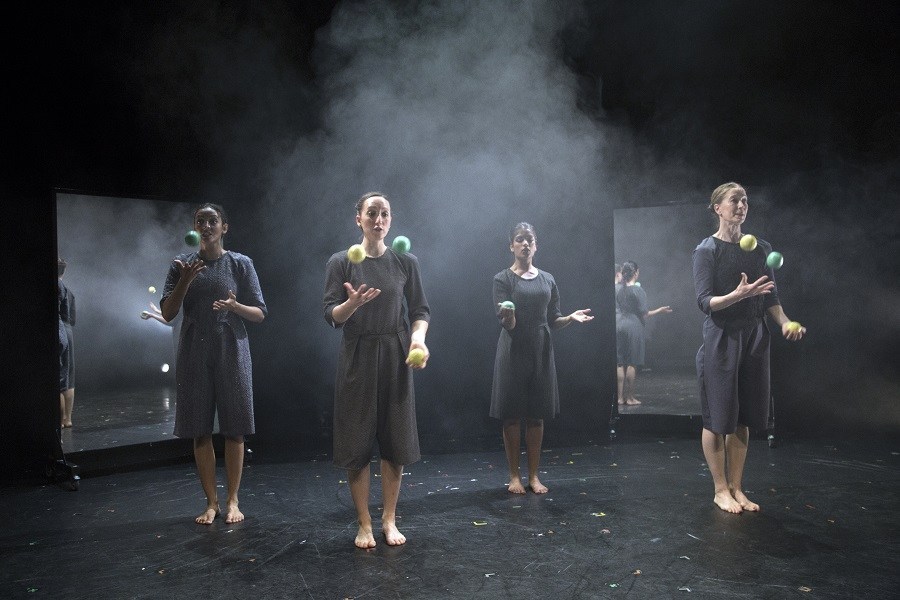Review from: Jane Mallet Theatre, Toronto; 16th March 2019

Sigma means the sum of small parts. This theme of many small parts making up a whole, while not a narrative in the traditional sense, is scattered throughout the show, and also speaks of its inception. A chance meeting through a mutual acquaintance… Long talks at the kitchen table… In the words of juggler and director Sean Gandini, his artistic relationship with bharatanatyam dancer and choreographer Seeta Patel began as a creative flirtation – a Tinder date of sorts – but has since blossomed into a long-term collaboration that continues to develop, change, and grow even after 500 or so dates. The lovechild of these two unlikely consorts is Sigma, a cross-cultural integration of dance and circus that pushes the classical and the contemporary together into a wonderful production that is sure to delight fans of both artforms.

Sigma is in part presented by Nova Dance, led by Toronto-based choreographer and dancer Nova Bhattacharya. Battacharya is herself an expert in merging classical Indian dance and contemporary movement in order to push boundaries and smash expectations. Bharatanatyam, a classical Indian artform that fuses dance, music, theatre, ritual practice, and math, is alive and well in the city of Toronto, but is completely new to me. When watching the bharatanatyam dance performed, I found myself attentive to the small details of the movement. Dancers Seeta Patel and Indu Panday use subtle facial movements – eyelids, cheeks, and eyebrows – to convey meaning, but it is their hands that tell the story of their dance. This works beautifully with the masterful technique of Gandini company jugglers Kati Ylä-Hokkala and Kim Huynh.

Each of the four performers has been with the show since it launched in 2017 and plays an integral part. It’s not that the dance or the juggling is complicated in and of itself (I have seen much more intricate juggling acts performed in other Gandini productions). It is how the women work together and how they have built a rapport and trust in one another that makes the show work so well. They work together to build one movement – be it juggling or dance – into the next, and weave the two art forms together seamlessly. The patterns that they create together demonstrate the complexity of the work and make it all the more intriguing to those of us watching in awe from the audience.

Furthering the idea of small parts creating a sum is the actual structure of the show. The complete performance is marked by twelve acts. Some of the acts flow into each other while others are delineated by the cast and specifically named and introduced. The show begins with the women veiled, each one taking turns to share her hopes for the outcome of the show. As the first act proceeds they are hidden behind two screens performing. It is mysterious and magical to watch their silhouetted figures move through dance and juggling anonymously. The four women could be interchangeable. We cannot see who is dancer and who is juggler. They are parts of the show, but they do not have an identity yet.

The veils are shed and the screens become mirrors reflecting and enhancing the symmetry and geometric patterns found naturally within the dance and juggling. There are pieces that focus on juggling. There are pieces that focus on the dance. There are solos and group numbers that bind the four women together in a complicated tangle of arms, legs, and juggling balls. The music is rhythmic and pulsing at times, while at other times there is no music at all save for the performers’ recitations and melodic thumping of the dancers soles on the heavy wooden stage. The set is fairly bare throughout, with costuming, props, and lighting kept simple and neutral.

Throughout these acts, each woman briefly shares the parts that came together to make her – her birthdate, her hometown, and the lineage of her own parents. The spoken words are a personal touch that introduce the audience to the performers and allows us to know them just a little bit more. They are no longer the performer, the juggler, the dancer. They are Seeta, Indu, Kati, and Kim. It seems as though we are all sitting around that kitchen table sharing stories, jokes, and hopes. We are all in on the flirtation and want to be a part of this unique and beautiful relationship that has brought two different worlds together into one outstanding performance.
Sigma is currently on tour throughout Southern Ontario, Canada.




